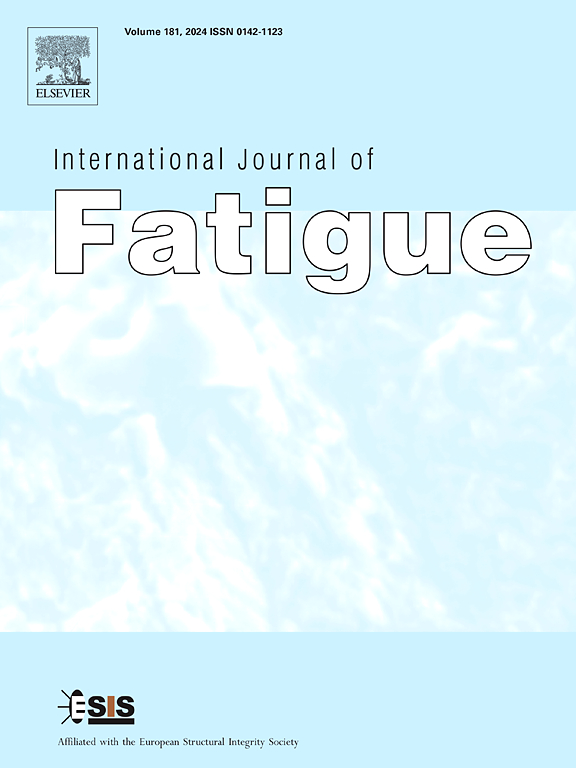Fatigue performance and failure mechanisms of vacuum brazed AISI 304L joints with experimental nickel-based filler metals in air and corrosive environments
IF 5.7
2区 材料科学
Q1 ENGINEERING, MECHANICAL
引用次数: 0
Abstract
Brazing with nickel-based filler metals under vacuum is frequently applied for joining metals in applications that require high resistance to mechanical loads, corrosive environments and elevated temperatures. However, melting-point depressant elements in the filler can lead to brittle phases in the brazing seam, affecting crack initiation and propagation. This study investigated cylindrical butt joints of metastable austenitic AISI 304L, brazed with NiCrSiB–based fillers containing iron and molybdenum. Tensile, fatigue and corrosion tests were applied to identify the most promising filler for subsequent corrosion fatigue experiments in a self-developed test chamber. Results in air showed that fatigue performance close to AISI 304L can be achieved, when problematic Kirkendall voids and athermal brittle phases are avoided. Corrosion fatigue tests in aqueous environments with varying sodium chloride concentrations and elevated temperatures revealed that cracked chromium-rich borides in the diffusion-affected zone act as microgalvanic elements, accelerating corrosion fatigue via hydrogen embrittlement. At 80 °C, these mechanisms became widespread, leading to multiple crack initiations across the steel surface and not just in the brazing seam. Hence, this study highlights the complex interplay of microstructure, cyclic loading, and environmental effects, offering key insights into the failure mechanisms of vacuum-brazed joints under combined mechanical and corrosive stresses.
真空钎焊AISI 304L接头在空气和腐蚀环境中的疲劳性能及失效机理
在真空下用镍基填充金属钎焊通常用于连接需要高机械负荷、腐蚀性环境和高温的应用中的金属。然而,钎料中的熔点抑制元素会导致钎缝中出现脆性相,影响裂纹的萌生和扩展。本研究研究了亚稳奥氏体AISI 304L圆柱对接接头,用含铁和钼的nicrsibb基填料钎焊。在自行研制的腐蚀疲劳试验箱中,通过拉伸、疲劳和腐蚀试验,确定了最有希望用于后续腐蚀疲劳试验的填料。空气试验结果表明,当避免有问题的Kirkendall空洞和非热脆性相时,可以获得接近AISI 304L的疲劳性能。在不同氯化钠浓度和高温的水环境中进行的腐蚀疲劳试验表明,扩散影响区破裂的富铬硼化物充当微电元素,通过氢脆加速腐蚀疲劳。在80°C时,这些机制变得普遍,导致整个钢表面产生多重裂纹,而不仅仅是在钎焊缝中。因此,本研究强调了微观结构、循环载荷和环境影响的复杂相互作用,为真空钎焊接头在机械和腐蚀联合应力下的破坏机制提供了关键见解。
本文章由计算机程序翻译,如有差异,请以英文原文为准。
求助全文
约1分钟内获得全文
求助全文
来源期刊

International Journal of Fatigue
工程技术-材料科学:综合
CiteScore
10.70
自引率
21.70%
发文量
619
审稿时长
58 days
期刊介绍:
Typical subjects discussed in International Journal of Fatigue address:
Novel fatigue testing and characterization methods (new kinds of fatigue tests, critical evaluation of existing methods, in situ measurement of fatigue degradation, non-contact field measurements)
Multiaxial fatigue and complex loading effects of materials and structures, exploring state-of-the-art concepts in degradation under cyclic loading
Fatigue in the very high cycle regime, including failure mode transitions from surface to subsurface, effects of surface treatment, processing, and loading conditions
Modeling (including degradation processes and related driving forces, multiscale/multi-resolution methods, computational hierarchical and concurrent methods for coupled component and material responses, novel methods for notch root analysis, fracture mechanics, damage mechanics, crack growth kinetics, life prediction and durability, and prediction of stochastic fatigue behavior reflecting microstructure and service conditions)
Models for early stages of fatigue crack formation and growth that explicitly consider microstructure and relevant materials science aspects
Understanding the influence or manufacturing and processing route on fatigue degradation, and embedding this understanding in more predictive schemes for mitigation and design against fatigue
Prognosis and damage state awareness (including sensors, monitoring, methodology, interactive control, accelerated methods, data interpretation)
Applications of technologies associated with fatigue and their implications for structural integrity and reliability. This includes issues related to design, operation and maintenance, i.e., life cycle engineering
Smart materials and structures that can sense and mitigate fatigue degradation
Fatigue of devices and structures at small scales, including effects of process route and surfaces/interfaces.
 求助内容:
求助内容: 应助结果提醒方式:
应助结果提醒方式:


